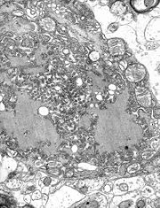
Rabies
Overview
Rabies (ˈreɪbiːz. From , "madness") is a viral
disease that causes acute encephalitis
(inflammation of the brain
) in warm-blooded animals. It is zoonotic (i.e., transmitted by animals), most commonly by a bite from an infected animal. For a human, rabies is almost invariably fatal if post-exposure prophylaxis
is not administered prior to the onset of severe symptoms. The rabies virus infects the central nervous system, ultimately causing disease in the brain and death.
The rabies virus
travels to the brain by following the peripheral nerves
.
Virus
A virus is a small infectious agent that can replicate only inside the living cells of organisms. Viruses infect all types of organisms, from animals and plants to bacteria and archaea...
disease that causes acute encephalitis
Encephalitis
Encephalitis is an acute inflammation of the brain. Encephalitis with meningitis is known as meningoencephalitis. Symptoms include headache, fever, confusion, drowsiness, and fatigue...
(inflammation of the brain
Brain
The brain is the center of the nervous system in all vertebrate and most invertebrate animals—only a few primitive invertebrates such as sponges, jellyfish, sea squirts and starfishes do not have one. It is located in the head, usually close to primary sensory apparatus such as vision, hearing,...
) in warm-blooded animals. It is zoonotic (i.e., transmitted by animals), most commonly by a bite from an infected animal. For a human, rabies is almost invariably fatal if post-exposure prophylaxis
Post-exposure prophylaxis
Post-exposure prophylaxis is any prophylactic treatment started immediately after exposure to a pathogen , in order to prevent infection by the pathogen and the development of disease.-Rabies:...
is not administered prior to the onset of severe symptoms. The rabies virus infects the central nervous system, ultimately causing disease in the brain and death.
The rabies virus
Rabies virus
The rabies virus is neurotropic virus that causes fatal disease in human and animals. Rabies transmission can occur through the saliva of animals....
travels to the brain by following the peripheral nerves
Peripheral nervous system
The peripheral nervous system consists of the nerves and ganglia outside of the brain and spinal cord. The main function of the PNS is to connect the central nervous system to the limbs and organs. Unlike the CNS, the PNS is not protected by the bone of spine and skull, or by the blood–brain...
.
Unanswered Questions

